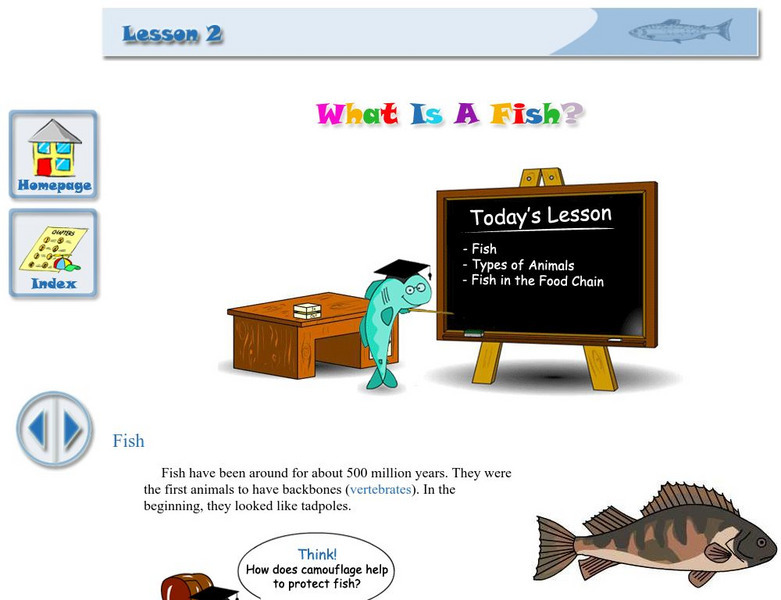Hi, what do you want to do?
Curated OER
Aquarium Bill of Rights
Students review the Bill of Rights on Aquademics and list the rights that are guaranteed to United States citizens. In groups, they role play the role of important leaders whose rules would make a difference for the lives of fish in...
Curated OER
Japanese Fish Printing
Students examine the characteristics of Japanese fish printing. Using a fresh or frozen fish, they create their own unique fish print. They paint the fish in the colors they chose and place it on a piece of colored paper. They...
Curated OER
An Imaginary Tropical Fish
Students examine the fins and mouths of different types of fish to discover what it eats and where it lives. They discuss that the types of fish are different because they adapted to different lifestyles. They develop a lifestyle of an...
Curated OER
Fish Aquarium
Students make an aquarium for fish out of construction paper. They count the number of fish in their aquarium, as well as, recognize the colors of their fish.
Curated OER
CREATE A FISH
Students watch a video that helps shows them how a diagram, flow chart, or blueprint can help them create a 3-d fish with the correct anatomy to live in a realistic environment.
Curated OER
Fish Workings
Learners observe, hypothesize, and draw conclusions regarding fish. They examine their anatomy, and how they function in their environment.
Curated OER
A Fish in Water
First graders, with a goldfish as a class pet, practice the proper way to care for a pet and have responsibilities when it comes to taking care of the fish. As a class, the teacher reads the book "Fish Out of Water".
Curated OER
One, Two Jumping Fish
Students watch video segments of counting fish. They participate in counting fish in an activity.
Curated OER
Something Fishy
Learners identify and discuss the adaptive characteristics and behaviors of fish. They view slides of fish, and design and create a model of a fish of the future, listing the ways their fish adapt to survive.
Curated OER
String of Fish
Fourth graders research a Florida fish to determine its length. They display this information on two index cards, which are cut to the shape of the head and the tail and attached to a string that they measure and cut to the correct...
Curated OER
Something Fishy
Students synthesize what they have learned about the anatomy of fish and their methods of adapting to survive.
Curated OER
Fish and Oxygen
Students explore what factors affect population dynamics, identify factors affecting fish populations, and use Stella to model how dissolved oxygen affects fish populations.
Curated OER
Investigation 11 - Utah Fish
Fourth graders examine a particular Utah fish and then create a poster that shares what they learned. They access websites imbedded in this plan to aide them in their research.
Curated OER
Zapping Fish
Students explore whether fish get electrocuted when the lightning strikes a lake.
Curated OER
Go Fish:
Third graders imagine that they are asked to determine the number of fish in a nearby pond. To count the fish one by one, they could remove the fish from the pond and stack them to one side, or mark each fish so they would not count them...
Curated OER
Swim Like a Whale or Fish?
Students recognize the difference between whales and fish by categorizing them according to their method of swimming. They synthesize this information by simulating the swimming patterns of whales and fish and comparing it to their own.
Curated OER
Whale or Fish?
Students explain the difference between a whale and a fish. After working through this themselves, they process the differences in a more meaningful pattern that overflows into long-term memory.
Inland Fisheries Ireland
Something Fishy: What Is a Fish?
Something fishy site invites users to discover more about fish and fish types by learning how fish use their gills to breathe as well as where they fit in the food chain.
PBS
Pbs Learning Media: Underwater
Explain which fish you would want to be in this school and why. [0:38]
Tramline
Tramline, Inc.: Virtual Ocean Field Trip
In this enchanting site, students will learn basic principles about oceans and will be introduced to an assortment of sea life, both plant and animal. Other interesting ocean links can be found on the teacher resource section of this link.
Science Education Resource Center at Carleton College
Serc: Lake Investigation: Determining Lake Type and Health Using the Internet
In this learning activity, students will analyze different lakes using the Lake Finder program on the Minnesota Department of Natural Resources website to research lake characteristics and their health. Students will be completing a...
Sheppard Software
Sheppard Software: Parrotfish
This site gives an in-depth description of a parrotfish, including its behavior, appearance, reproduction, and classification. The site includes photos and illustrations and an interactive quiz to test your understanding.
Language Guide
Language Guide: Los Animales Del Mar (Spanish)
This resource provides colorful pictures of sea animals interact with audio and the written vocabulary word as you move your mouse over the picture. This vocabulary would compliment a science unit on marine life.
Chase Young, PhD
Dr. Chase Young, Ph D: Reader's Theater Script: The Fish Tank [Pdf]
A reader's theater script for Lee Karvonen's book, The Fish Tank, is provided on these pages. Nine character roles are needed in this activity.



























